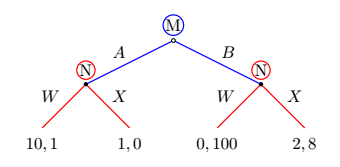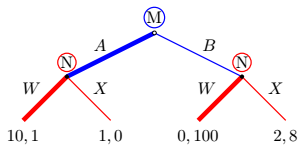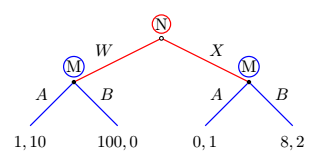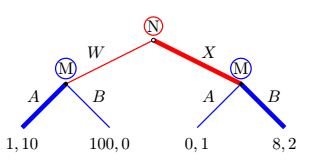Questions
Consider the following game:
| Player N | |||
|---|---|---|---|
| W | X | ||
| Player M | A | 10 , 1 | 1 , 0 |
| B | 0 , 100 | 2 , 8 | |
Question 1
Find all Nash equilibria of the game (i.e., the equilibria if the game is played simultaenously).Question 2
Imagine that the game is played sequentially, with Player M going first and Player N going second after observing Player M's decision. Find the subgame-perfect Nash equilibrium.Question 3
Imagine that the game is played sequentially, with Player N going first and Player M going second after observing Player N's decision. Find the subgame-perfect Nash equilibrium.Solutions
Question 1
{A ; W } is the unique Nash equilibrium.
| Player N | |||
|---|---|---|---|
| W | X | ||
| Player M | A | 10 , 1 | 1 , 0 |
| B | 0 , 100 | 2 , 8 | |
Question 2
{A ; W , W } is the unique subgame-perfect Nash equilibrium.
The sequential game is:

Equilibrium strategies are represented in the figure below with thicker lines. Player N will select W in both cases (following A because 1>0 and following B because 100>8). Then, player 1 would earn 10 from A or 0 from B.

Question 3
{X ; A , B } is the unique subgame-perfect Nash equilibrium.
The sequential game is:

Note that the order of the payoffs is reversed from the simultaneous game so that the payoffs of the player going first (Player N) are listed first. Equilibrium strategies are represented in the figure below with thicker lines. If Player N selects W, Player M will select A (10>0). If Player N selects X, Player M will select B (2>1). Then, Player N expects a payoff of 1 from W or 8 from X so will select X.


